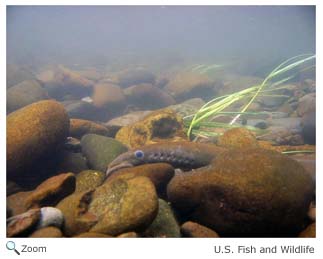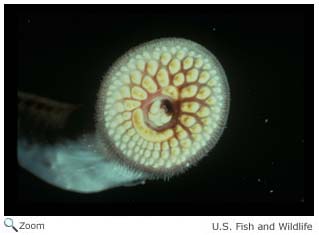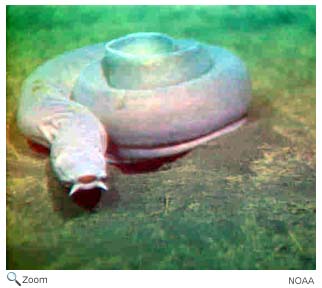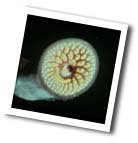Selected Species Around the World |
Broadgilled Hagfish - Eptatretus cirrhatus   
Brook Lamprey - Lampetra planeri    
Brown Hagfish - Paramyxine atami  
Cape Hagfish - Myxine capensis    
Carpathian Lamprey - Eudontomyzon danfordi   
Dwarf Hagfish- Myxine pequenoi  
Eightgilled Hagfish - Eptatretus octatrema   
Fivegill Hagfish - Eptatretus profundus   
Goliath Hagfish - Eptatretus goliath   
Greek Brook Lamprey - Eudontomyzon hellenicus  
|
|
Lombardy Brook Lamprey - Lampetra zanandreai  
Longfin Hagfish - Eptatretus longipinnis   
Lulua River Lamprey - Aplocheilichthys katangae  
Non-parasitic Lamprey - Mordacia praecox  
River Lamprey - Lampetra fluviatilis     
Sixgill Hagfish - Eptatretus hexatrema     
Southern Hagfish - Myxine australis   
Strickrott's Hagfish - Eptatretus strickrotti  
Ukranian Brook Lamprey - Eudontomyzon mariae    
Vladykov's Lamprey - Eudontomyzon vladykovi  
White-headed Hagfish - Myxine ios    |
Additional Information
Key:  Profile Profile  Photos Photos  Video Video  Audio Audio  NH Species NH Species
American Brook Lamprey - Lampetra appendix     
The American brook lamprey is found in the eastern U.S. and southeastern Canada.
Source:US Geological Survey Intended Audience: General Reading Level: Middle School
Atlantic Hagfish - Myxine glutinosa        
The Atlantic hagfish is found on both sides of the north Atlantic Ocean.
Source: Sea and Sky Intended Audience: Student Reading Level: Middle School
Atlantic Hagfish - Myxine glutinosa        
The Atlantic hagfish preys on shrimp, worms, and small crabs
Source: NOAA Intended Audience: General Reading Level: Middle School
Brook Lamprey - Lampetra planeri    
The brook lamprey is found in small brooks, streams, lakes, and rivers across Europe.
Source: Arkive Intended Audience: General Reading Level: Middle School
Northern Brook Lamprey - Ichthyomyzon fossor   
Northern brook lamprey are found in many areas of the midwestern and northeastern United States.
Source: Animal Diversity Web Intended Audience: General Reading Level: Middle School
Southern Brook Lamprey - Ichthyomyzon gagei   
Southern brook lampreys are found in the Mississippi River basin, the Tennessee River drainage, and Gulf of Mexico drainages.
Source: Animal Diversity Web Intended Audience: General Reading Level: Middle School
River Lamprey - Lampetra fluviatilis      
The river lamprey is found in western Europe from Sweden and Finland south to France and east to Russia.
Source: Arkive Intended Audience: General Reading Level: Middle School
Sea Lamprey - Petromyzon marinus        
The sea lamprey is found on both sides of the North Atlantic.
Source: Arkive Intended Audience: General Reading Level: Middle School
Sea Lamprey - Petromyzon marinus       
In North American the sea lamprey is found on the east coast of United States and Canada.
Source: EEK - Environmental Education for Kids Intended Audience: Students Reading Level: Elementary School
Pacific Hagfish - Eptatretus stoutii    
The Pacific hagfish is found on muddy bottoms in cold ocean waters along the Pacific Coast from Vancouver, Canada south to Baja California, Mexico.
Source: Animal Diversity Web Intended Audience: General Reading Level: Middle School
Pacific Hagfish - Eptatretus stoutii    
The Pacific hagfish is also known as the slime eel.
Source: Monterey Bay Aquarium Intended Audience: General Reading Level: Middle School
Pacific Hagfish - Eptatretus stoutii    
The hagfish can tie itself into a knot.
Source: Aquarium of the Pacific Intended Audience: General Reading Level: Middle School
Pacific Hagfish - Eptatretus stoutii    
Hagfish eat worms and invertebrates, but they also enter both dying and dead fish and eat them from the inside out.
Source: Oregon Coast Aquarium Intended Audience: General Reading Level: Middle School
Pacific Hagfish - Eptatretus stoutii    
Hagfish have been around, mostly unchanged, since the Paleozoic era 450 million years ago.
Source: California Department of Fish and Wildlife Intended Audience: General Reading Level: Middle School
Pacific Lamprey - Entosphenus tridentatus    
The Pacific lamprey is born in fresh water, matures in the ocean, and returns to fresh water to reproduce. It dies after reproduction.
Source: U.S. Fish and Wildlife Intended Audience: General Reading Level: Middle School |





 Agnatha Photo Gallery
Agnatha Photo Gallery